计算机网络原理习题讲解
计算机网络-习题与解答
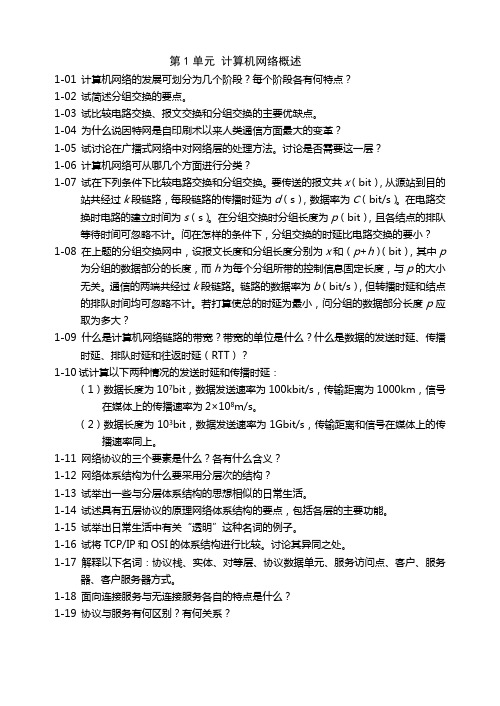
第1单元计算机网络概述1-01 计算机网络的发展可划分为几个阶段?每个阶段各有何特点?1-02 试简述分组交换的要点。
1-03 试比较电路交换、报文交换和分组交换的主要优缺点。
1-04 为什么说因特网是自印刷术以来人类通信方面最大的变革?1-05 试讨论在广播式网络中对网络层的处理方法。
讨论是否需要这一层?1-06 计算机网络可从哪几个方面进行分类?1-07 试在下列条件下比较电路交换和分组交换。
要传送的报文共x(bit),从源站到目的站共经过k段链路,每段链路的传播时延为d(s),数据率为C(bit/s)。
在电路交换时电路的建立时间为s(s)。
在分组交换时分组长度为p(bit),且各结点的排队等待时间可忽略不计。
问在怎样的条件下,分组交换的时延比电路交换的要小?1-08 在上题的分组交换网中,设报文长度和分组长度分别为x和(p+h)(bit),其中p 为分组的数据部分的长度,而h为每个分组所带的控制信息固定长度,与p的大小无关。
通信的两端共经过k段链路。
链路的数据率为b(bit/s),但转播时延和结点的排队时间均可忽略不计。
若打算使总的时延为最小,问分组的数据部分长度p应取为多大?1-09 什么是计算机网络链路的带宽?带宽的单位是什么?什么是数据的发送时延、传播时延、排队时延和往返时延(RTT)?1-10试计算以下两种情况的发送时延和传播时延:(1)数据长度为107bit,数据发送速率为100kbit/s,传输距离为1000km,信号在媒体上的传播速率为2×108m/s。
(2)数据长度为103bit,数据发送速率为1Gbit/s,传输距离和信号在媒体上的传播速率同上。
1-11 网络协议的三个要素是什么?各有什么含义?1-12 网络体系结构为什么要采用分层次的结构?1-13 试举出一些与分层体系结构的思想相似的日常生活。
1-14 试述具有五层协议的原理网络体系结构的要点,包括各层的主要功能。
计算机网络第一章习题解答

第一章概述1-01 计算机网络向用户可以提供那些服务?答:连通性和共享1-02 试简述分组交换的要点。
答:采用存储转发的分组交换技术,实质上是在计算机网络的通信过程中动态分配传输线路或信道带宽的一种策略。
它的工作机理是:首先将待发的数据报文划分成若干个大小有限的短数据块,在每个数据块前面加上一些控制信息(即首部),包括诸如数据收发的目的地址、源地址,数据块的序号等,形成一个个分组,然后各分组在交换网内采用“存储转发” 机制将数据从源端发送到目的端,到达目的端后再按照一定的方式方法进行组装成一个数据块。
分组交换网是由若干节点交换机和连接这些交换机的链路组成,每一结点就是一个小型计算机。
基于分组交换的数据通信是实现计算机与计算机之间或计算机与人之间的通信,其通信过程需要定义严格的协议。
分组交换网的主要优点:1、高效。
在分组传输的过程中动态分配传输带宽。
2、灵活。
每个结点均有智能,可根据情况决定路由和对数据做必要的处理。
3、迅速。
以分组作为传送单位,在每个结点存储转发,网络使用高速链路。
4、可靠。
完善的网络协议;分布式多路由的通信子网。
电路交换相比,分组交换的不足之处是:①每一分组在经过每一交换节点时都会产生一定的传输延时,考虑到节点处理分组的能力和分组排队等候处理的时间,以及每一分组经过的路由可能不等同,使得每一分组的传输延时长短不一。
因此,它不适用于一些实时、连续的应用场合,如电话话音、视频图像等数据的传输;②由于每一分组都额外附加一个头信息,从而降低了携带用户数据的通信容量;③分组交换网中的每一节点需要更多地参与对信息转换的处理,如在发送端需要将长报文划分为若干段分组,在接收端必须按序将每个分组组装起来,恢复出原报文数据等,从而降低了数据传输的效率。
1-03 试从多个方面比较电路交换、报文交换和分组交换的主要优缺点。
(教材11—15)1-04 为什么说因特网是自印刷术以来人类通信方面最大的变革?答:融合其他通信网络,在信息化过程中起核心作用,提供最好的连通性和信息共享,第一次提供了各种媒体形式的实时交互能力。
(完整版)计算机网络原理课后习题答案
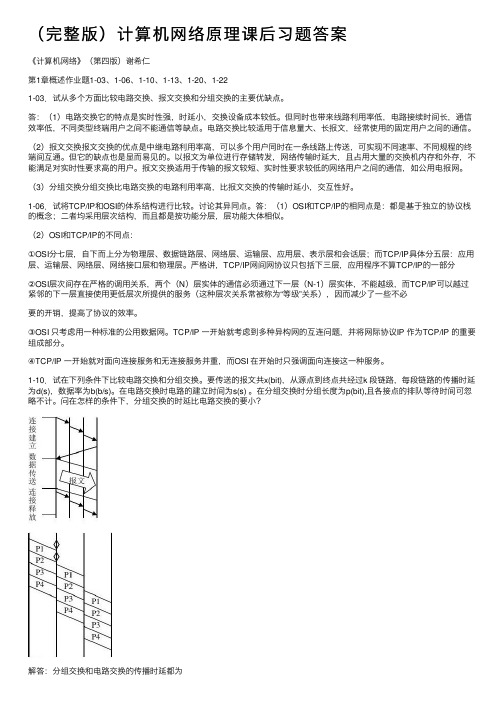
(完整版)计算机⽹络原理课后习题答案《计算机⽹络》(第四版)谢希仁第1章概述作业题1-03、1-06、1-10、1-13、1-20、1-221-03.试从多个⽅⾯⽐较电路交换、报⽂交换和分组交换的主要优缺点。
答:(1)电路交换它的特点是实时性强,时延⼩,交换设备成本较低。
但同时也带来线路利⽤率低,电路接续时间长,通信效率低,不同类型终端⽤户之间不能通信等缺点。
电路交换⽐较适⽤于信息量⼤、长报⽂,经常使⽤的固定⽤户之间的通信。
(2)报⽂交换报⽂交换的优点是中继电路利⽤率⾼,可以多个⽤户同时在⼀条线路上传送,可实现不同速率、不同规程的终端间互通。
但它的缺点也是显⽽易见的。
以报⽂为单位进⾏存储转发,⽹络传输时延⼤,且占⽤⼤量的交换机内存和外存,不能满⾜对实时性要求⾼的⽤户。
报⽂交换适⽤于传输的报⽂较短、实时性要求较低的⽹络⽤户之间的通信,如公⽤电报⽹。
(3)分组交换分组交换⽐电路交换的电路利⽤率⾼,⽐报⽂交换的传输时延⼩,交互性好。
1-06.试将TCP/IP和OSI的体系结构进⾏⽐较。
讨论其异同点。
答:(1)OSI和TCP/IP的相同点是:都是基于独⽴的协议栈的概念;⼆者均采⽤层次结构,⽽且都是按功能分层,层功能⼤体相似。
(2)OSI和TCP/IP的不同点:①OSI分七层,⾃下⽽上分为物理层、数据链路层、⽹络层、运输层、应⽤层、表⽰层和会话层;⽽TCP/IP具体分五层:应⽤层、运输层、⽹络层、⽹络接⼝层和物理层。
严格讲,TCP/IP⽹间⽹协议只包括下三层,应⽤程序不算TCP/IP的⼀部分②OSI层次间存在严格的调⽤关系,两个(N)层实体的通信必须通过下⼀层(N-1)层实体,不能越级,⽽TCP/IP可以越过紧邻的下⼀层直接使⽤更低层次所提供的服务(这种层次关系常被称为“等级”关系),因⽽减少了⼀些不必要的开销,提⾼了协议的效率。
③OSI 只考虑⽤⼀种标准的公⽤数据⽹。
TCP/IP ⼀开始就考虑到多种异构⽹的互连问题,并将⽹际协议IP 作为TCP/IP 的重要组成部分。
计算机网络吴功宜(第三版)课后习题解答(第1-4章)
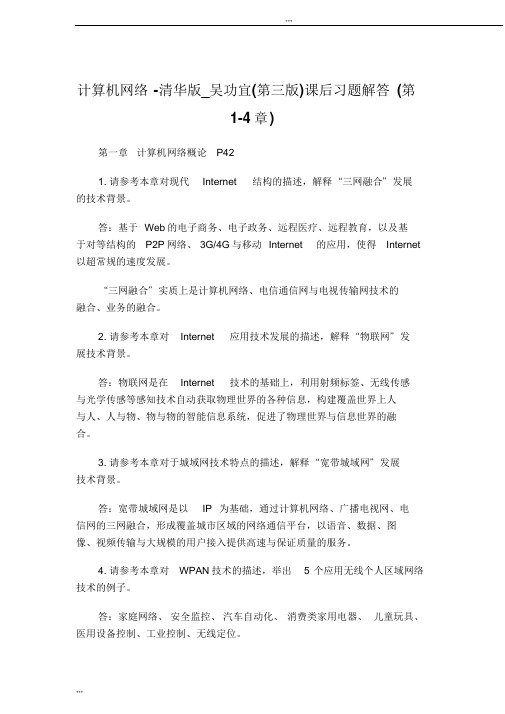
计算机网络-清华版_吴功宜(第三版)课后习题解答(第1-4 章)第一章计算机网络概论P421. 请参考本章对现代Internet 结构的描述,解释“三网融合”发展的技术背景。
答:基于Web的电子商务、电子政务、远程医疗、远程教育,以及基于对等结构的P2P网络、3G/4G与移动Internet 的应用,使得Internet 以超常规的速度发展。
“三网融合”实质上是计算机网络、电信通信网与电视传输网技术的融合、业务的融合。
2. 请参考本章对Internet 应用技术发展的描述,解释“物联网”发展技术背景。
答:物联网是在Internet 技术的基础上,利用射频标签、无线传感与光学传感等感知技术自动获取物理世界的各种信息,构建覆盖世界上人与人、人与物、物与物的智能信息系统,促进了物理世界与信息世界的融合。
3. 请参考本章对于城域网技术特点的描述,解释“宽带城域网”发展技术背景。
答:宽带城域网是以IP 为基础,通过计算机网络、广播电视网、电信网的三网融合,形成覆盖城市区域的网络通信平台,以语音、数据、图像、视频传输与大规模的用户接入提供高速与保证质量的服务。
4. 请参考本章对WPAN技术的描述,举出 5 个应用无线个人区域网络技术的例子。
答:家庭网络、安全监控、汽车自动化、消费类家用电器、儿童玩具、医用设备控制、工业控制、无线定位。
5.. 请参考本章对于Internet 核心交换、边缘部分划分方法的描述,举出身边 5 种端系统设备。
答:PDA、智能手机、智能家电、无线传感器节点、RFID 节点、视频监控设备。
7. 长度8B与536B的应用层数据通过传输层时加上了20B的TCP报头, 通过网络层时加上60B 的IP 分组头,通过数据链路层时加上了18B 的Ethernet 帧头和帧尾。
分别计算两种情况下的数据传输效率。
(知识点在:P33)解:长度为8B的应用层数据的数据传输效率:8/(8+20+60+18) ×100%=8/106×100%=7.55%长度为536B的应用层数据的数据传输效率:536/(536+20+60+18) ×100%=536/634×100%=84.54%8. 计算发送延时与传播延时。
计算机网络 谢希仁 第四章习题解答
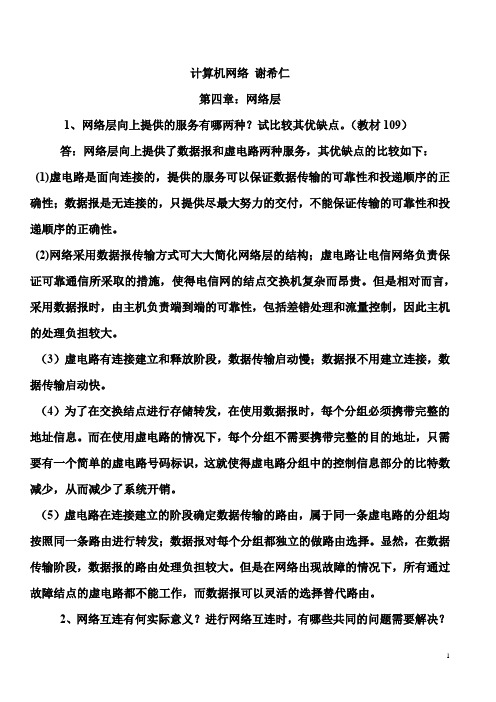
计算机网络谢希仁第四章:网络层1、网络层向上提供的服务有哪两种?试比较其优缺点。
(教材109)答:网络层向上提供了数据报和虚电路两种服务,其优缺点的比较如下:(1)虚电路是面向连接的,提供的服务可以保证数据传输的可靠性和投递顺序的正确性;数据报是无连接的,只提供尽最大努力的交付,不能保证传输的可靠性和投递顺序的正确性。
(2)网络采用数据报传输方式可大大简化网络层的结构;虚电路让电信网络负责保证可靠通信所采取的措施,使得电信网的结点交换机复杂而昂贵。
但是相对而言,采用数据报时,由主机负责端到端的可靠性,包括差错处理和流量控制,因此主机的处理负担较大。
(3)虚电路有连接建立和释放阶段,数据传输启动慢;数据报不用建立连接,数据传输启动快。
(4)为了在交换结点进行存储转发,在使用数据报时,每个分组必须携带完整的地址信息。
而在使用虚电路的情况下,每个分组不需要携带完整的目的地址,只需要有一个简单的虚电路号码标识,这就使得虚电路分组中的控制信息部分的比特数减少,从而减少了系统开销。
(5)虚电路在连接建立的阶段确定数据传输的路由,属于同一条虚电路的分组均按照同一条路由进行转发;数据报对每个分组都独立的做路由选择。
显然,在数据传输阶段,数据报的路由处理负担较大。
但是在网络出现故障的情况下,所有通过故障结点的虚电路都不能工作,而数据报可以灵活的选择替代路由。
2、网络互连有何实际意义?进行网络互连时,有哪些共同的问题需要解决?(教材110)答:(1)单一的网络无法满足各种用户的多种需求,因此,把许多种不同类型的物理网络互相连接在一起,可以实现更大范围内的通信。
实际中使用的TCP/IP 协议,定义了一种抽象的网络,隐藏了互连的各种不同物理网络的细节,使得互连后的网络像一个单一的大网络。
(2)进行网络互连时,需要解决的共同的问题:不同的寻址方案、不同的最大分组的长度、不同的网络接入机制、不同的超时控制、不同的差错恢复方法、不同的状态报告方法、不同的路由选择技术、不同的用户接入控制、不同的服务(面向连接的服务和无连接的服务)、不同的网络管理和控制方式等。
《计算机网络》第6章课后习题
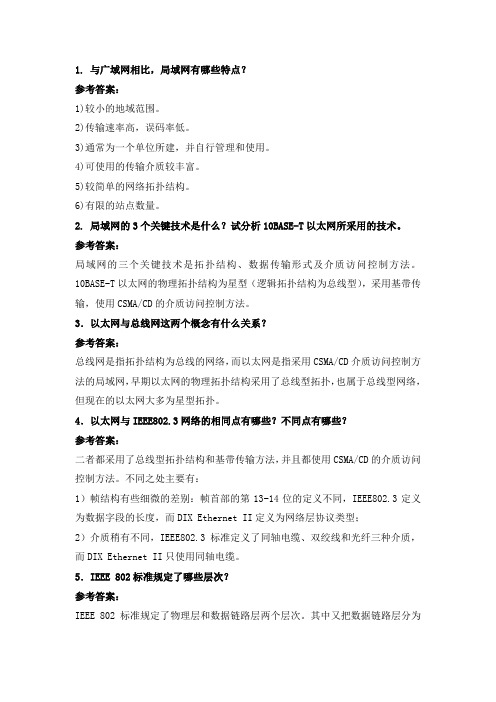
1.与广域网相比,局域网有哪些特点?参考答案:1)较小的地域范围。
2)传输速率高,误码率低。
3)通常为一个单位所建,并自行管理和使用。
4)可使用的传输介质较丰富。
5)较简单的网络拓扑结构。
6)有限的站点数量。
2. 局域网的3个关键技术是什么?试分析10BASE-T以太网所采用的技术。
参考答案:局域网的三个关键技术是拓扑结构、数据传输形式及介质访问控制方法。
10BASE-T以太网的物理拓扑结构为星型(逻辑拓扑结构为总线型),采用基带传输,使用CSMA/CD的介质访问控制方法。
3.以太网与总线网这两个概念有什么关系?参考答案:总线网是指拓扑结构为总线的网络,而以太网是指采用CSMA/CD介质访问控制方法的局域网,早期以太网的物理拓扑结构采用了总线型拓扑,也属于总线型网络,但现在的以太网大多为星型拓扑。
4.以太网与IEEE802.3网络的相同点有哪些?不同点有哪些?参考答案:二者都采用了总线型拓扑结构和基带传输方法,并且都使用CSMA/CD的介质访问控制方法。
不同之处主要有:1)帧结构有些细微的差别:帧首部的第13-14位的定义不同,IEEE802.3定义为数据字段的长度,而DIX Ethernet II定义为网络层协议类型;2)介质稍有不同,IEEE802.3标准定义了同轴电缆、双绞线和光纤三种介质,而DIX Ethernet II只使用同轴电缆。
5.IEEE 802标准规定了哪些层次?参考答案:IEEE 802标准规定了物理层和数据链路层两个层次。
其中又把数据链路层分为逻辑链路控制(LLC)和介质访问控制(MAC)两个功能子层。
6.试分析CSMA/CD介质访问控制技术的工作原理。
参考答案:CSMA/CD介质访问控制技术被广泛应用于以太网中。
CSMA/CD的工作原理是:当某个站点要发送数据时,它首先监听介质:①如果介质是空闲的,则发送;②如果介质是忙的,则继续监听,一旦发现介质空闲,就立即发送;③站点在发送帧的同时需要继续监听是否发生冲突(碰撞),若在帧发送期间检测到冲突,就立即停止发送,并向介质发送一串阻塞信号以强化冲突,保证让总线上的其他站点都知道已发生了冲突;④发送了阻塞信号后,等待一段随机时间,返回步骤①重试。
计算机网络原理复习第三章习题
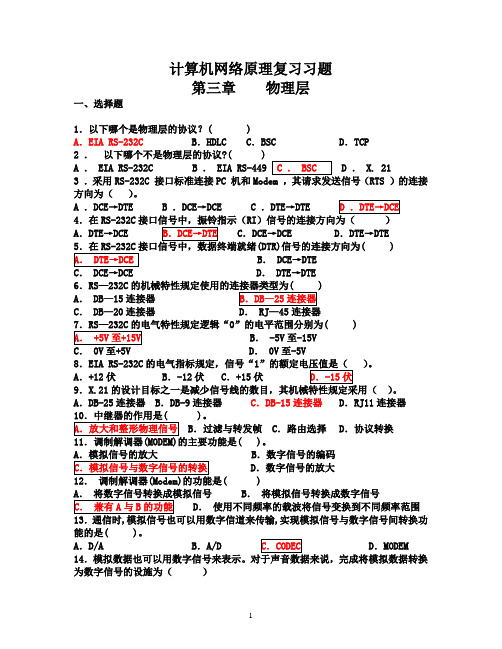
计算机网络原理复习习题第三章物理层一、选择题1.以下哪个是物理层的协议?( )A.EIA RS-232C B.HDLC C.BSC D.TCP2 .以下哪个不是物理层的协议A . EIA RS-232CB .. X. 213 .采用RS-232C 接口标准连接PC 机和RTS )的连接方向为()。
A .DCE→DTEB .DCE→DCEC .DTE→DTE4.在RS-232C RIA.DTE→.DCE→DCE D.DTE→DTE(DTR)信号的连接方向为( ). DCE→DTE. DTE→DTE6.RS—232CA. DB—15连接器C. DB—20连接器( ). -5V至-15V. 0V至-5V8.EIA RS-232C)。
A.+12伏B.-12伏C.+15伏9.X.21)。
A.DB-25连接器 B.DB-9连接器C.DB-15连接器D.RJ11连接器。
.过滤与转发帧 C.路由选择D.协议转换( )。
.数字信号的编码D.数字信号的放大( )B.将模拟信号转换成数字信号.使用不同频率的载波将信号变换到不同频率范围,实现模拟信号与数字信号间转换功能的是( )。
A.D/A B.A/D D.MODEM14为数字信号的设施为().编码解码器(CODEC)中的解码器.调制解调器(MODEM)中的解调器15( )。
A.编码.解码D.解调16( )。
A.解调 B.解码 C.调制17A.调频 B.调幅 C.正交相移18.)B.调频C.相位调制D.幅度相位调制方式进行。
A.单工.半双工D.全双工20种通信方式为( )A.并行.单工D.全双工( ).只能在一个方向上传输D.以上均不对22( )A.单工方式 B.半双工方式.多路复用方式B.报文交换D.分组交换与电路交换结合( )B.信道所能提供的同时通话的路数.信道所允许的最大误码率( )C.计算机与外设之间的通信都采用并行方式D.与并行方式相比,串行方式的传输速率更大27.在下面的说法中,( )是正确的。
计算机网络_第3章习题解答
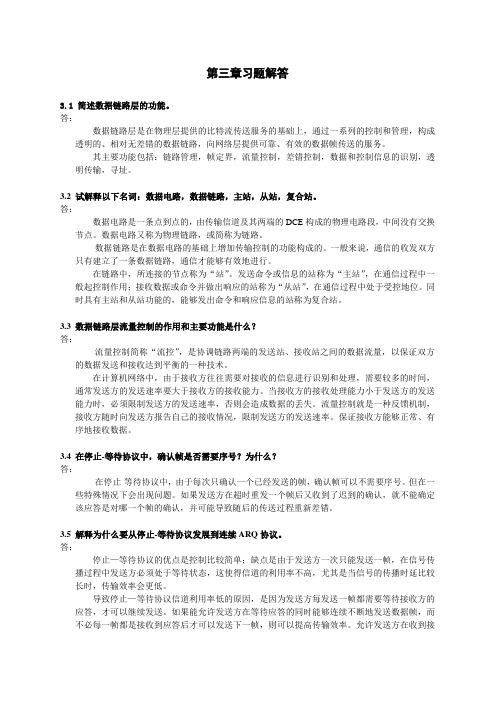
第三章习题解答3.1简述数据链路层的功能。
答:数据链路层是在物理层提供的比特流传送服务的基础上,通过一系列的控制和管理,构成透明的、相对无差错的数据链路,向网络层提供可靠、有效的数据帧传送的服务。
其主要功能包括:链路管理,帧定界,流量控制,差错控制,数据和控制信息的识别,透明传输,寻址。
3.2 试解释以下名词:数据电路,数据链路,主站,从站,复合站。
答:数据电路是一条点到点的,由传输信道及其两端的DCE构成的物理电路段,中间没有交换节点。
数据电路又称为物理链路,或简称为链路。
数据链路是在数据电路的基础上增加传输控制的功能构成的。
一般来说,通信的收发双方只有建立了一条数据链路,通信才能够有效地进行。
在链路中,所连接的节点称为“站”。
发送命令或信息的站称为“主站”,在通信过程中一般起控制作用;接收数据或命令并做出响应的站称为“从站”,在通信过程中处于受控地位。
同时具有主站和从站功能的,能够发出命令和响应信息的站称为复合站。
3.3 数据链路层流量控制的作用和主要功能是什么?答:流量控制简称“流控”,是协调链路两端的发送站、接收站之间的数据流量,以保证双方的数据发送和接收达到平衡的一种技术。
在计算机网络中,由于接收方往往需要对接收的信息进行识别和处理,需要较多的时间,通常发送方的发送速率要大于接收方的接收能力。
当接收方的接收处理能力小于发送方的发送能力时,必须限制发送方的发送速率,否则会造成数据的丢失。
流量控制就是一种反馈机制,接收方随时向发送方报告自己的接收情况,限制发送方的发送速率。
保证接收方能够正常、有序地接收数据。
3.4 在停止-等待协议中,确认帧是否需要序号?为什么?答:在停止-等待协议中,由于每次只确认一个已经发送的帧,确认帧可以不需要序号。
但在一些特殊情况下会出现问题。
如果发送方在超时重发一个帧后又收到了迟到的确认,就不能确定该应答是对哪一个帧的确认,并可能导致随后的传送过程重新差错。
3.5 解释为什么要从停止-等待协议发展到连续ARQ协议。
- 1、下载文档前请自行甄别文档内容的完整性,平台不提供额外的编辑、内容补充、找答案等附加服务。
- 2、"仅部分预览"的文档,不可在线预览部分如存在完整性等问题,可反馈申请退款(可完整预览的文档不适用该条件!)。
- 3、如文档侵犯您的权益,请联系客服反馈,我们会尽快为您处理(人工客服工作时间:9:00-18:30)。
Chapter I 1. What is the difference between a host and an end system List the types of end systems. Is a Web server an end system 2. What is a client program What is a server program Does a server program request and receive services from a client program 3. List six access technologies. Classify each one as residential access, company access, or mobile access. 4. Dial-up modems, HFC, and DSL are all used for residential access. For each of these access technologies, provide a range of transmission rates and comment on whether the transmission rate is shared or dedicated. 5. Describe the most popular wireless Internet access technologies today. Compare and contrast them. 6. What advantage does a circuit-switched network have over a packet-switched network What advantages does TDM have over FDM in a circuit-switched network 7. Consider sending a packet from a source host to a destination host over a fixed route. List the delay components in the end-to-end delay. Which of these delays are constant and which are variable 8. How long does it take a packet of length 2,000 bytes to propagate over a link of distance
2,000 km, propagation speed 8102 m/s, and transmission rate 2 Mbps More generally, how long does it take a packet of length L to propagate over a link of distance d, propagation speed s, and transmission rate R bps Does this delay depend on packet length Does this delay depend on transmission rate 9. What are the five layers in the Internet protocol stack What are the principal responsibilities of each of these layers 10. Which layers in the Internet protocol stack does a router process Which layers does a link-layer switch process Which layers does a host process 11. What is an application-layer message A transport-layer segment A network-layer datagram A link-layer frame 12. This elementary problem begins to explore propagation delay and transmission delay, two central concepts in data networking. Consider two hosts, A and B, connected by a single link of rate R bps. Suppose that the two hosts are separated by m meters, and suppose the propagation speed along the link is s meters/sec. Host A is to send a packet of size L bits to Host B.
a. Express the propagation delay, propd, in terms of m and s.
b. Determine the transmission time of the packet,transd, in terms of L and R. c. Ignoring processing and queuing delays, obtain an expression for the end-to-end delay. d. Suppose Host A begins to transmit the packet at time t = 0. At time transdt,where is the last bit of the packet e. Suppose propd is greater than transd. At time t = transd,where is the first bit of the packet f. Suppose propd is less than transd. At time t = transd, where is the first bit of the packet
g. Suppose 8105.2s, L = 100bits, and R = 28 kbps. Find the distance m so that propd equals transd. 13. In modern packet-switched networks, the source host segments long, application-layer messages (for example, an image or a music file) into smaller packets and sends the packets into the network. The receiver then reassembles the packets back into the original message. We refer to this process as message segmentation. Figure 1.24 illustrates the end-to-end transport of a message with and without message segmentation. Consider a message that is
6108 bits long that is to be sent from source to destination in Figure 1.24. Suppose each
link in the figure is 2 Mbps. Ignore propagation, queuing, and processing delays. a. Consider sending the message from source to destination without message segmentation. How long does it take to move the message from the source host to the first packet switch Keeping in mind that each switch uses store-and-forward packet switching, what is the total time to move the message from source host to destination host b. Now suppose that the message is segmented into 4,000 packets, with each packet being 2,000 bits long. How long does it take to move the first packet from source host to the first switch When the first packet is being sent from the first switch to the second switch, the second packet is being sent from the source host to the first switch. At what time will the second packet be fully received at the first switch c. How long does it take to move the file from source host to destination host when message segmentation is used Compare this result with your answer in part (a) and comment. d. Discuss the drawbacks of message segmentation. 14. 下列说法中,正确的是( )。 A.在较小范围内布置的一定是局域网,币在较大范围内布置的一定是广域网 B.城域网是连接广域网而覆盖园区的网络 C.城域网是为淘汰局域网和广域网而提出的一种网络技术 D.局域网是基于广播技术发展起来的网络,广域网是基于交换技术发展起来的向络 解答:D。 通常而言,局域网的覆盖范围较小,而广域网的覆盖范围较大,但这并不绝对。有时候在一个不大的范围内采用广域网,这取决于应用的需要和是否采用单一网络等多种因素。特别是局域网技术的进步,使得其覆盖范围越来越大,达到几十千米的范围。 城域网是利用广域网技术、满足一定区域需求的一种网络,事实上,城域网的范围弹性非常大。 最初的局域网采用广播技术,这种技术一直被沿用,而广域网最初使用的是交换技术,也一直被沿用。 ? 15. 相对于o⒏的7层参考模型的低4层,TCP/IP协议集内对应的层次有( )。 A.传输层、互联网层、网络接口层和物理层 B.传输层、互联网层、网络接口层 C.传输层、互联网层、ATM层和物理层
